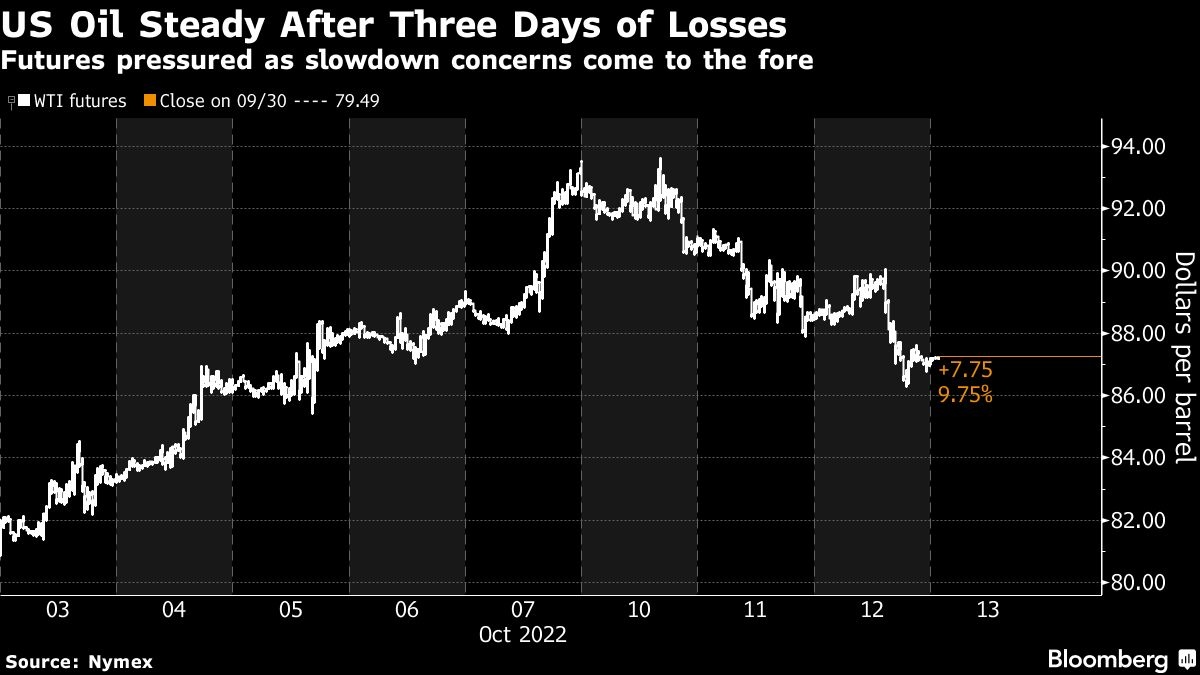Oct 13, 2022
Oil heads for longest losing run since 2021 on slowdown concerns
, Bloomberg News
Today’s oil price is the same as pre-2008 crisis: BI strategist
Oil fell for a fourth day, set for the longest losing run in more than a year, as investors fretted that a global slowdown would hurt energy consumption and an industry report pointed to a major build in U.S. inventories.
West Texas Intermediate fell toward US$87 a barrel following a drop of almost six per cent over the prior three days. On Wednesday, minutes from the Federal Reserve showed officials committed to raising interest rates to a restrictive level and holding them there to curb inflation, potentially slowing growth.
Figures from the industry-funded American Petroleum Institute, meanwhile, showed an increase of more than seven million barrels last week, according to people familiar with the release. Official data will follow later Thursday.

Crude rallied last week as the Organization of Petroleum Exporting Countries and its allies agreed to cut oil supply, but that advance has been partially unwound since Monday. Traders have become increasingly concerned about the scope for a global recession and slump in oil consumption, as well as the drag from a strengthening dollar and China’s COVID Zero strategy.
“The dominant and persistent force is recessionary fears,” said Vandana Hari, founder of Vanda Insights in Singapore. That said, “the correction from last week’s overbought territory may be almost through. Brent may find a temporary bottom around US$90,” she said.
Prices:
- WTI for November delivery shed 0.3 per cent to US$87.02 a barrel on the New York Mercantile Exchange at 7:40 a.m. in London.
- Earlier, prices fell as much as 0.5 per cent. A fourth day of losses would be the worst run since August 2021.
Brent for December settlement was 0.2 per cent lower at US$92.29 a barrel on the ICE Futures Europe exchange.
OPEC reduced forecasts for the amount of its crude needed this quarter, according to a monthly report on Wednesday. The International Energy Agency will release its analysis of the market later Thursday, shedding further light on demand trends and the likely impact of sanctions on Russian crude flows.
To step up the response to Moscow’s invasion of Ukraine, U.S. officials are leading a plan to impose a cap on the price of Russia’s crude, complementing tighter European Union sanctions that kick in from December. Countries working to impose the cap will meet over the next several weeks to determine the specific price ceilings, according to a senior U.S. Treasury official.
The week has been studded with warnings that growth will slow as monetary policy tightens. U.S. President Joe Biden conceded that the US risks a recession, although he played down the likelihood of that outcome. The International Monetary Fund and World Bank also flagged increasing risks.
A stronger U.S. dollar -- with a Bloomberg gauge of the currency trading near a record set last month -- is also adding to headwinds for crude as it makes the commodity becomes more expensive for overseas buyers.
Widely-watched time spreads have weakened this week. Brent’s prompt spread -- the difference between the two nearest contracts -- was US$1.61 a barrel in backwardation, compared with more than US$2 at the end of last week.



